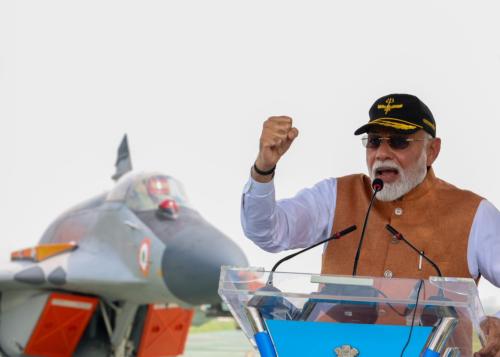Particularly since the rise of the so-called Islamic State in 2013, one of the most widely held theories in international political and policymaker circles has been that a “twisted” or “radical” violent ideology, informed by a perverse interpretation of Islam, lies at the root of the rise in recruitment and radicalization to extremist groups. The logic that follows is: If you eradicate or defeat this ideology, there will be a corresponding drop in the violent extremist threat. President Trump and Secretary of State Mike Pompeo are among the most ardent advocates of this theory, and the understanding underpins the 2018 U.S. counterterrorism strategy.
The solution governments tout has frequently focused on getting political and so-called moderate religious leaders to denounce this ideology; identifying “authentic” voices in local communities—typically women, youth, or other community leaders, or better yet, former extremists—“to help dissuade a young person from finding that ideology appealing.” This is accompanied by training these individuals or groups on how to develop and disseminate these “counter-messages.” Regional counter-messaging centers have even been established around the world to build the capacity of locally-rooted civil society actors to produce and propagate tailored narratives that can push back against the violent ones being peddled by violent extremist groups, and to tackle online radicalization.
“Counter-narratives,” “alternative narratives,” and other “counter-messaging” efforts continue to have global appeal among donors, particularly in the face of the so-called Islamic State’s sophisticated media capabilities and dissemination of slick digital content to accelerate recruitment. Examples of such well-intended initiatives include the French government’s launch of the #stopviolentJihadisme social media campaign, which specifically challenged narratives aimed at women, and featured the release of a shock video campaign to try to discourage French youth from traveling to the conflict zones in Syria and Iraq, by telling them: “You’ll find hell on earth and you’ll die alone, far from home.” The Peer-2-Peer Challenging Extremism Program launched by the U.S. government in 2015 (and now a public-private partnership with Facebook) supports efforts of college students around the globe to develop social media tools and online campaigns to counter violent extremist narratives. However, as one expert has rightly noted, “[e]ven if one were to accept the premise that these initiatives provide a compelling counter-narrative, it’s uncertain how such initiatives are even meant to reach the target audience.” In fact, even if they reach the target audience, there is no guarantee that these narratives are, in fact, compelling. Moreover, “why would a ‘vulnerable’ individual engage with such apps or websites and how can we be certain that they are even aware of them to begin with?” As our research has shown, many of these efforts have been driven by political considerations (including a preference for short-term measures and an aversion to risk), the desire to be seen to be doing something (particularly something that does not implicate the behavior of the state), or untested and, in some cases, erroneous assumptions.
The evidence please?
Despite their popularity, there is little proof that counter-narratives in isolation are effective in reducing the threat of violent extremism. It remains far from clear that counter-narrative projects and programs are informed by contextual research or even designed with local input to increase the chances that content will resonate in the very communities they are meant to influence. Meanwhile, the field has a propensity to focus overtly on online radicalization and ignore the significance of offline contact in the radicalization process. This is to not to deny the fact that the internet can be a key enabling factor in establishing and fostering the development of radicalisation, as underscored in recent studies focused on right-wing extremism. However, available research does not suggest that online terrorist propaganda is a causative factor in extremist violence and it questions the relationship between ideas and behaviors.
The field has therefore been subject to criticism. A recent European Parliament study on counter-narratives concluded that “the concept itself is rather underdeveloped and lacks a thorough grounding in empirical research.” Expanding on this, our colleague Andrew Glazzard writes that many existing counter-narrative programs rely on shaky metrics and sparse empirical foundations, lack a fully articulated theory to underpin their impact, and often fail to differentiate between radicalization and recruitment to violence.
Reviewing the existing evidence base in 2016, one expert challenged the prevailing assumptions that the consumption of violent words leads to violent deeds, counter-narratives can replace terrorist narratives, and the threat of violent extremism can be mitigated through discourse. Research does indicate that certain patterns of communication, including hate speech, dehumanization, and identity-based messaging can help create conditions conducive for violent extremism; however, they are not analogous and any causal relationship remains unproven. Responding to each set of violent extremist narratives and its intended audience with a specifically designed counter-narrative fails to address why violent extremist rhetoric is “appealing in the first place.” Advocating retaliatory communications-based responses may therefore “underplay” the significance of identity, grievance, and trust in radicalization processes, and risk a superficial response that addresses the symptoms rather than the causes of violent extremism.
Despite this and other skepticism surrounding the efficacy of the use of counter-narratives in countering extremist violence, it has not led to any decline in their use. In fact, the opposite seems to be true.
Why the appeal?
Among the reasons for the continued global popularity of counter-narrative initiatives—and the need to empower credible voices—is that it allows the focus to remain on the behavior and ideology of the violent extremists and not on the predatory and other counter-productive behavior of governments towards their citizens and the grievance-generating structural issues in a society. This helps explain why 74 countries in the global coalition have perhaps over focused on “countering Daesh’s propaganda” (Daesh is the Arabic acronym for ISIS)—in order “to oppose Daesh’s narrative and to undermine the appeal of its ideology… [and] to assist[and amplify] credible and authentic voices from the region.”
Other reasons for the over-emphasis on counter-narrative and counter-messaging work more broadly relate to the fact that it is often more concrete and short-term in nature, and perceived as being more easily measurable than initiatives focused on addressing grievances or otherwise changing conditions on the ground. However, these metrics tend to focus exclusively on output-level data collating audience figures and immediate commentary or responses to media content, rather than diagnosing any substantive change in, for example, an individual’s propensity or preference for violence. These evaluations are almost impossible to generalize and offer little analysis on the effectiveness of projects beyond fairly superficial benchmarks.
The challenge?
The desire to demonstrate action has awarded unwarranted attention to the counter-narrative field often at the expense of serious consideration for how human rights violations—often committed in the name of countering terrorism and violent extremism—and local governance failures, for example, are fueling violent extremism.
The good news is that donors have doubled-down on investments in research on what drives and mitigates violent extremist threats; thus our understanding of the causes of extremist violence and evidence base of what works and doesn’t continues to improve. In fact, despite the above criticisms, there are ongoing valiant efforts—though unfortunately mostly unattributed and unpublicized—by some institutions to develop clear monitoring measurements and robust indicators of success beyond the production of output level data. There is also a growing recognition of the potential effectiveness of combining counter-narrative activities with other preventive processes. These include one-to-one mentoring, the provision of psycho-social care, or the development of critical thinking skills. Finally, and perhaps most significantly, there is a growing understanding, particularly among researchers and practitioners, that “successful” counter-narratives are dependent on a variety of factors. It is important to construct a compelling alternative and present peaceful visions that resonate with local people, as well as restrict the online space for extremist narratives to flourish. At the same time, policymakers must acknowledge the backdrop of often unaddressed socio-economic and political factors, which were responsible for the rise of violent extremism in the first place.
The bad news is that while we are hopeful the ongoing research will lead to more effective counter-narrative projects, we are more pessimistic when it comes to addressing these underlying structural factors, which the research has identified. There, what’s needed is changes in the behavior of the governments whose military, law enforcement, and intelligence cooperation has been central to killing and capturing terrorists. So long as preserving and even strengthening this security cooperation remains the overwhelming priority, the obstacles to incentivizing the necessary behavioral changes will remain high, and counter-narratives will likely continue to receive undue attention.
The Brookings Institution is committed to quality, independence, and impact.
We are supported by a diverse array of funders. In line with our values and policies, each Brookings publication represents the sole views of its author(s).








Commentary
Do counter-narratives actually reduce violent extremism?
March 20, 2019